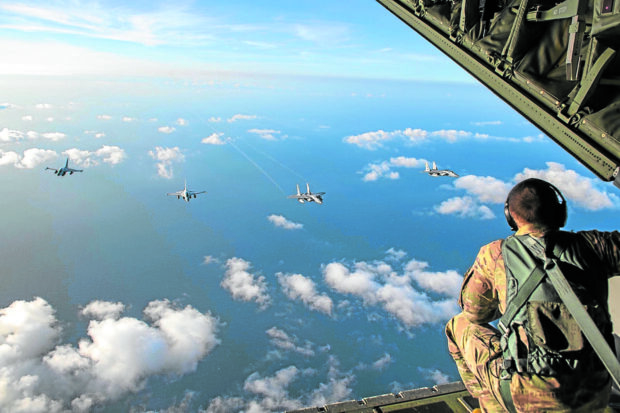
EYE IN THE SKY | Two FA-50PH aircraft of the Philippine Air Force (first two from left) fly alongside US fighter jets in a joint patrol over the West Philippine Sea on Nov. 21, 2023, as seen from another US military aircraft. Philippine and US Navy ships are also taking part in the patrol.
(From the 5TH Fighter Wing and 353rd Special Operations Wing of the US Air Force)
MANILA, Philippines — A Chinese Navy guided-missile frigate and a surveillance plane kept watch on the joint maritime patrol of the Philippines and the United States in the West Philippine Sea on Wednesday.
As a US Navy Poseidon P-8A surveillance aircraft flew overhead while the Philippine Navy’s BRP Conrado Yap (PS-39) sailed with the US Navy’s USS Gabrielle Giffords for a passing exercise, the People’s Liberation Army’s Navy Jiangkai-II frigate and a Shaanxi Y-9 surveillance aircraft operated in the vicinity.
There were no aggressive interactions from both sides, although the Jiangkai-II frigate came as close as 9.26 kilometers (5 nautical miles) from the USS Giffords.
“Nothing unusual. Both parties… conducted themselves safely and professionally and normally, which is what we’re always out here trying to do,” said Lt. Cmdr. Tim Cline, mission commander of the US Navy P-8A maritime patrol aircraft.
“The objective [of our operations here] is to normalize activity and normalize interactions with each other,” he said.
Prepared for anything
Lt. Cmdr. Robert Podolinski, the US Navy training officer aboard the P-8A, said they were prepared “for any possible contingency.”
“Whether it be an intercept or any kind of activity at sea, we just make sure that we’re prepared for it in the event that if anything does happen. We try to conduct ourselves in the most professional way possible in accordance with our international norms and standards that we have,” he said.
Cline said the presence of the P-8 served as “eyes in the sky” to ensure that all vessels in the vicinity were interacting safely and professionally.
The same type of aircraft has been spotted in recent resupply missions in Ayungin (Second Thomas) Shoal in the West Philippine Sea, where Chinese ships have harassed Philippine vessels.
“We were asked to come out and to work with our allies and the P-8 is an extremely successful asset that is capable of long-range intelligence, surveillance, and reconnaissance. We have the ability to stay on station for a long period of time and to provide that eyes in the sky for our surface units for whatever they’re conducting,” Cline added.
Not show of force
President Ferdinand Marcos Jr. announced the start of a three-day joint air and sea patrol between the Philippines and the US on Tuesday, in a show of closer military ties between the two allies amid rising tensions with China.
The patrols kicked off in Batanes, the province closest to Taiwan, where Beijing has stepped up its military activities. The patrols will wrap up in the WPS on Thursday.
On Tuesday, the Philippine Air Force’s FA-50 light combat aircraft flew in tandem with the US Air Force’s F-15C fighter jets and C-130 from Batanes to the West Philippine Sea to test joint flight doctrines and further enhance interoperability, according to the Armed Forces of the Philippines.
AFP spokesperson Col. Medel Aguilar said the patrols were not intended to be a show of force against any country.
“It is not meant to escalate the tension and all our actions and intentions are in accordance with international laws and conventions,” he explained.
“We hope China will also abide by international law and conventions that promote peaceful settlement of the conflict and the same convention that regulates their behavior at sea,” he said
Reacting to the ongoing joint maritime patrol, Chinese Foreign Ministry spokesperson Mao Ning said on Wednesday that “China has stated its position to the Philippines and the US. The joint patrol must not hurt China’s territorial sovereignty and maritime rights and interests.”
Mao’s statement was released by the Chinese Embassy in Manila.